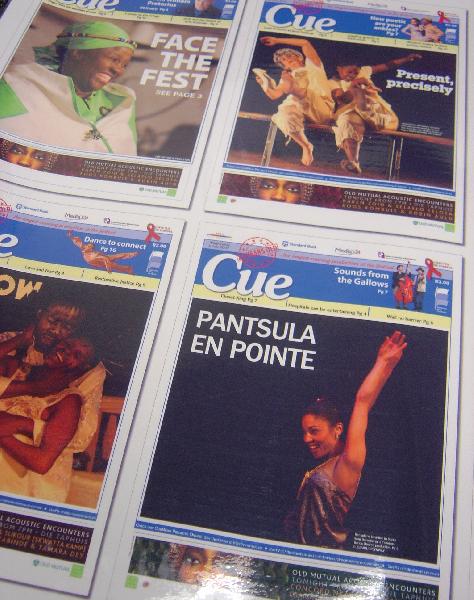
Here's a sign of the times. Take many thousands of people attending the National Arts Festival in Grahamstown, give them access to new media tools, and see what happens.
The result is an amazingly dynamic and multidimensional documenting of this mega-event, providing an unprecedented record of the tons of talent descending on this tiny Eastern Cape town.
Running from July 2 to 11, the festival offers choices of up to 50 items at any given moment. And that's just what's on the official programme. In the face of such cornucopia, this is where coverage comes in. It helps to make sense of the fest-frenzy, and it also reflects the event's totality back unto itself.
There was a time when the primary media platform about the festival was Cue newspaper, a daily publication that reviews the key drama, dance, art, and movies, not to mention delving into the doings of the visiting divas, crafters, sculptors, poets, street performers and so on.
The newspaper is produced by students and visiting professional journalists of the School of Journalism and Media Studies at Rhodes 老虎机游戏_pt老虎机-平台*官网, where I work. Over the past decade, this publication has spawned an ever-growing number of counterparts, like a photo-agency, web platform, a video channel, and audio spots.
This year, there's also a site for cellphones useful for people at the festival itself seeking guidance on what's good. Student-produced video is going out via Myvideo, and the audio is flighted via SAfm as well on podcast.
Multimedia slide shows are not only on the site run by the journalism school's New Media Lab, but selections are also being delivered via the web operations of City Press, the Daily Dispatch, iAfrica.com and AllAfrica.com.
Then there's Cueblog, which also carries festival video, being run by visiting Dutch students. Plus, you can see another site by students from ten South African journalism schools who are part of an initiative called the Future Journalism Project.
Mainstream media is also covering the festival online -- for instance the Herald has a concentrated-focus blog, and local paper Grocott's Mail has a lot of coverage, as would be expected.
Not surprisingly, you can also find headlines from all these in several Twitter
locations, like http://twitter.com/fest and http://twitter.com/lmuston, and http://twitter.com/grocotts.
Added to the mix, the festival itself is now doing its own media, both independently of, and in partnership with, other players. Their website includes a blog platform produced by freelance journalists, and a flickr photo-feed courtesy of cueblog.There is also some video on YouTube.
The official festival Twitter feed dispenses advice, answers questions and delivers alerts about what productions are cancelled or sold-out. A Facebook page also keeps fans updated. Fest director Tony Lankester has his own Twitter stream that trickles the occasional anecdotes between his hectic schedule.
But, wait! There's still more. On top of all this output, the audiences themselves are generating content about the festival. They're sending dozens of SMSs that appear on the festival's site, and quite a few are also doing independent posts on Twitter about what's hot or not.
I've sent out tweet summaries of some of the public lectures at the ThinkFest component of the festival. Other attendees at the festival are making independent comments on blogs, often giving gratuitous advice to performers about what should be done to improve a particular play.
Not all the audience-generated content is innocent or honest: some SMSs recommending specific shows sound suspiciously like self-interested promos.
But some SMS renditions give insight into why something is tops or terrible, and do so more informatively than the formal media's take. Sometimes these participants also shout out when the media screwed up, like correcting when one event was misrepresented as a puppet show. From these citizen correspondents, you can also find out, for instance, when the drumming begins at a well-know restaurant.
All-in-all, there's a massive outpouring of reportage and comment in text, image, video, audio, print, and online flash animations. Some is highly stuff, and much is highly subjective. But all of it gives insight into this otherwise transient concentration of culture in Grahamstown.
One limitation is that the existence of so many content generators has made it hard to aggregate it all. This is because contributors are using different keywords and Twitter tags, for instance, #artsfest, #artfest, #artfestNo and #festival. That there's no singular reference serves to inhibit the sense of communicators conversing about a common topic.
Ultimately, there's nothing like actually being at the festival in the flesh, rather than virtually via the media. But the extensive coverage going on is still a service to folks who are far away, and it enriches the experience of those living the buzz.
Just as no single person could can attend, or even comprehend, the totality of this mammoth event, so also is it becoming impossible to traverse all the media coverage on offer. However, like the festival itself, it's fun to just dip into the available wealth.
You might, for instance, enjoy a slide show on what emerges after performing hairdressers from Spain conscript someone from the watching crowd to be a guinea pig for really radical make-overs.
Or maybe you'll be tempted to look at a video on the Let's Talk Whiskey Workshop; or listen to a podcast in English or isiXhosa about a performance named umRhube about indigenous music .
It depends on what you like, and on what surprises captivate your interest. This vibrant media feast is a pointer to the future of content creation and circulation.
Story by: Guy Berger
